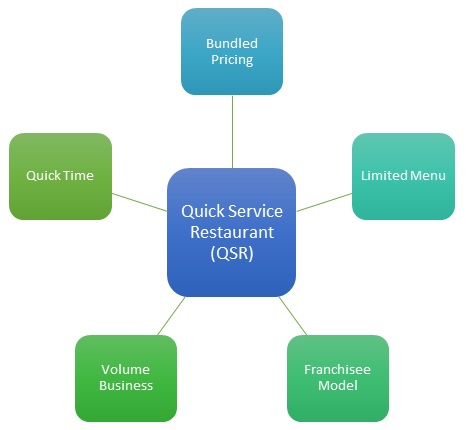Quick Service Restaurant (QSR) - Definition, Types & Example
What is Quick Service Restaurant (QSR)?
Quick service restaurant (QSR) is a restaurant which offer certain food items that require minimal preparation time and are delivered through quick services. Typically, quick service restaurants or QSRs cater to fast food items over a limited menu as they can be cooked in lesser time with minimum possible variation.
QSR restaurants are known to have standardized, modular and efficient processes which help them in reducing the lead times to fulfil the orders but still maintain the quality expected by the customers. Preparation methodology and usage of technology are pillars of a Quick service restaurant (QSR).
Quick Service Restaurant (QSR) Strategy
Quick service restaurants have much variety when it comes to the type of service they offer. There are also drive-through restaurants, which do not offer any tables or seats but rather collect the order and deliver it through a single counter. The orders are generally pre prepared and are highly standardized with no room for customization. These types of businesses don’t rely on margin over their services rather rely on the frequency of footfall. A key strategy used by quick service restaurants is the bundle pricing. QSR combine their food items on the menu into a bundle of complementary meals for example McDonald’s value meal of fries, a soft drink and a burger. Usually customers prefer these meals over individual food items as the former creates a sense of value addition and diversity to their expenditure. For the retailers, they give attractive discounts over bundled meals and set a substantial profit margin to lure from these offerings.

Read More
Types of Quick Service Restaurant (QSR)
Quick service restaurants generally function in a chains or franchises as they gain profit from the number of footfalls they receive. Operating multiple stores enables them to harness the footfall frequency from multiple locations and add to the company’s value. These restaurants often cater to complementary food items or just a single class of food stuff for example Starbucks. Starbucks offers beverage services along with light snacks which complements its taste. Similarly Pizza hut and Domino’s offer fast foods combined with light beverages. High degree of standardization is required at a QSR to deliver quick services to the customers that includes
1. Self service restaurants
In this type of QSR, the customers approach the ordering counter for both placing the order as well as collecting the order.
For receiving the order, they collect it by their own from the counter once it is prepared and notified.
2. Assisted self service restaurants
These QSRs are places where either the order is collected at the table of the customer or the food is delivered to the table of the customer by a staff member.
3. Full serviced restaurants
These are the places where both the order placing and the food delivery are done by the staff at the table.
Examples of Quick Service Restaurant (QSR)
Some real-life examples of quick service restaurants are Mc Donald’s, Subway, Burger King, KFC etc. Recent trends have shown a tremendous shift in the operations of local quick service restaurants. With rising number of food delivery services, these restaurants have started separating a division for food items which are cooked in bulk and then stored to be supplied to the delivery services. This does not only gives them an opportunity to earn margins by not investing in the restaurant seating spaces but also provides brand marketing for their restaurant brands.
Hence, this concludes the definition of Quick Service Restaurant (QSR) along with its overview.
This article has been researched & authored by the Business Concepts Team. It has been reviewed & published by the MBA Skool Team. The content on MBA Skool has been created for educational & academic purpose only.
Browse the definition and meaning of more similar terms. The Management Dictionary covers over 1800 business concepts from 5 categories.
Continue Reading:
What is MBA Skool?About Us
MBA Skool is a Knowledge Resource for Management Students, Aspirants & Professionals.
Business Courses
Quizzes & Skills
Quizzes test your expertise in business and Skill tests evaluate your management traits
Related Content
All Business Sections
Write for Us